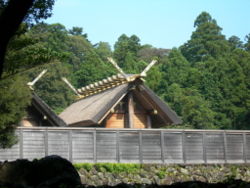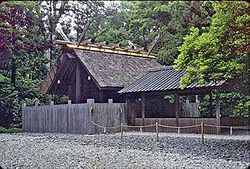- Ise-jingū
-
Le sanctuaire d'Ise, nommé en japonais Ise-jingū (伊勢神宮?) ou Ise Daijingū (伊勢大神宮?) est un sanctuaire shintoïste dédié à la déesse Amaterasu-ōmikami, construit dans la ville d'Ise (préfecture de Mie) au Japon.
Connu officiellement sous le nom de Jingū, Ise-jingū est en réalité un ensemble complexe composé de plus d'une centaine de petits temples, divisés en deux grandes parties :
- Le gekū (外宮), sanctuaire « extérieur », est situé dans la ville de Yamada et dédié au dieu Toyouke no ōmikami ;
- Le naikū (内宮), sanctuaire « intérieur », est situé dans la ville de Uji (différente de Uji) et dédié à Amaterasu-ōmikami. Les deux sanctuaires sont séparés de 6 km.
D'après la chronologie officielle, les sanctuaires ont été construits aux alentours de l'an -4, mais il est probable que la plupart ait été construits des siècles plus tard, plutôt vers 690
Ils sont mentionnés dans les annales du Kojiki et du Nihonshoki (datant, respectivement, de 712 et 720). Les anciens sanctuaires sont en ruines et les nouveaux sont reconstruits à leur image tous les 20 ans - les bâtiments actuels, qui datent de 1993, sont les 61e à avoir été construits, ils seront remplacés en 2013.
Réputé pour avoir abrité le miroir sacré de l'Empereur du Japon, le sanctuaire est probablement l'un des lieux les plus sacrés du shintoïsme. L'accès aux lieux est règlementé, le public ne peut visiter qu'une partie des sanctuaires.
Le sanctuaire d'Ise est un élément du patrimoine national du Japon.
De plus, le sentier d'Ise (伊勢路, Iseji?) (environ 160km), qui relie Ise à Kumano Sanzan (熊野三山?) est incrit depuis 2004 au patrimoine mondial de l'UNESCO, comme élément de l'ensemble des sites sacrés et chemins de pèlerinage dans les monts Kii.
Voir aussi
Liens externes
- (en), (zh), (ja) Ise-jingū
- Jingū - Mie Tourism Guide (Préfecture de Mie) (fr), (en), (zh), (jp)
- Ville d'Ise Information touristique (Syndicat du tourisme de la ville d'Ise) (fr), (es), (en), (zh), (jp)
- Wikitravel: Ise (en)
Wikimedia Foundation. 2010.



